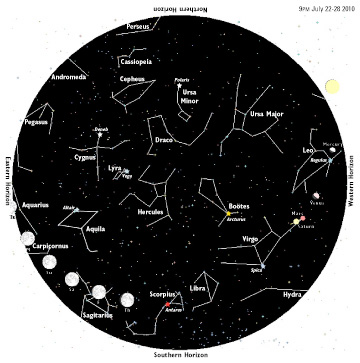Chesapeake Bay's Independent Newspaper ~ Since 1993
1629 Forest Drive, Annapolis, MD 21403 ~ 410-626-9888
Volume xviii, Issue 29 ~ July 22 - July 28, 2010
Home \\ Correspondence \\ from the Editor \\ Submit a Letter \\ Classifieds \\ Contact Us
Best of the Bay \\ Dining Guide \\ Home & Garden Guide \\ Archives \\ Distribution \\ Advertising![]()


Sky Watch

by J. Alex Knoll
Standing Up to the Moon
July’s Thunder Moon deadens all but the brightest lights
The gibbous moon waxes through southern skies this week, becoming full on the 25th. July’s full moon is known as the Hay Moon or the Thunder Moon. Rising at dusk and setting at dawn, the full moon dominates the sky this week, blotting out all but the brightest planets and stars.
As the sun sets in the northwest before 8:25 this week, the first light to appear is the evening star Venus, 20 degrees above the western horizon. As dusk gives way to darkness, Venus is joined by ruddy Mars and golden Saturn to the left. This week Venus races westward night by night, leading up to a three-planet conjunction next week.
To the right of Venus, hugging the western horizon at nightfall, is bluish Regulus, the brightest star in the constellation Leo. Closer still to the horizon is our solar system’s innermost planet, Mercury, shining twice as bright as Regulus. At magnitude –0.2, Mercury is outshined by only Venus, Jupiter and Canis Major. Yet because this elusive planet never strays farther than 20 degrees from the sun’s blinding glare, it can be one of the most difficult objects to see. Over the coming nights Mercury inches higher, closing the gap between Regulus until Tuesday, when they appear less than one-half degree apart.
Jupiter rises in the east after 11pm and dominates the sky between the dim constellations Aquarius and Pisces. By the approach of daybreak, around 6am this week, Jupiter is high in the south.
Between dusk and dawn, summer’s bright stars stand up to the glare of the moon. Look for rosy-hued Arcturus, the fourth-brightest star, high in the west at sunset. Below it is Spica, the 16th brightest star, and low in the south shines Antares, the 19th brightest. Far to the east are the stars of the Summer Triangle: Vega, the fifth-brightest star; Altair, the 12th-brightest; and Deneb, the 19th-brightest.
Illustration: © Copyright 1925 M.C. Escher/Cordon Art-Baarn-Holland; Graphics: © Copyright 2010 Pacific Publishers. Reprinted by permission from the Tidelog graphic almanac. Bound copies of the annual Tidelog for Chesapeake Bay are $14.95 ppd. from Pacific Publishers, Box 480, Bolinas, CA 94924. Phone 415-868-2909. Weather affects tides. This information is believed to be reliable but no guarantee of accuracy is made by Bay Weekly or Pacific Publishers. The actual layout of Tidelog differs from that used in Bay Weekly. Tidelog graphics are repositioned to reflect Bay Weekly’s distribution cycle.Tides are based on National Oceanic and Atmospheric Administration and are positioned to coincide with high and low tides of Tidelog.
© COPYRIGHT 2010 by New Bay Enterprises, Inc. All rights reserved.
